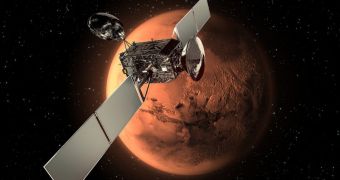After NASA abandoned the ExoMars project, much to the dismay of American scientists, the European Space Agency (ESA) turned to the Russian Federal Space Agency (RosCosmos) for help. The Russians agreed to supply a Proton rocket for the mission.
The announcement was made on March 15, by a European official. RosCosmos will donate the delivery system in exchange for a seat on the scientific council that will manage the atmospheric gas analyzer and telecommunications orbiter ESA wants to launch in 2016.
The project also calls for the integration of an entry, descent and landing module within ExoMars. The latter will enter the Martian atmosphere, land at a safe location, and then conduct a series of experiments before it runs out of power.
Also on March 15, the ruling council of ESA decided to continue funding this project, even though NASA – a principal partner – withdrew from the joint endeavor earlier this year. The American space agency is strapped for cash under the new budget covering fiscal year 2013.
With the new decision, ESA contractors in France and Italy were given a free-light to start working on the mission. The collaboration, led by Thales Alenia Space, now benefits from a full development contract, which calls for ExoMars to be ready to fly by 2016.
While ESA regards ExoMars as a single, large program, it in fact has two separate components. The first is the orbiter/lander combo, to be launched four years from now, and the second is a large, European-built rover, accompanied by another entry, descent and landing module.
The second module will be built primarily by RosCosmos (80 percent), with only some contributions (20 percent) from ESA. Together, the four spacecraft make up the entire ExoMars project, Space reports.
With NASA out of the picture, the program is expected to set ESA back by about 1.2 billion euros ($1.59 billion). This level is already way above what the European Commission decided to pay when the project was first proposed, so mission controllers are threading a very fine line.

 14 DAY TRIAL //
14 DAY TRIAL //